Rheingau (wine region)
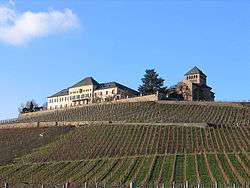
Rheingau is one of 13 designated German wine regions (Weinbaugebiete) producing quality wines (QbA and Prädikatswein). It was named after the traditional region of Rheingau (meaning "Rhine district"), the wine region is situated in the state of Hesse, where it constitutes part of the Rheingau-Taunus-Kreis administrative district. Although, making up only 3 percent of the total German vineyard area, Rheingau has been the source of many historically important innovations in German wine making, and contains many wine producers of international reputation, such as Schloss Johannisberg. Rheingau, with 3,125 hectares (7,720 acres) of vineyards in 2008, also boasts a higher proportion of Riesling (78.8%) than any other German wine-growing region, with Spätburgunder (Pinot noir) making up most of the rest (12.2%), followed by Müller-Thurgau (1.6%).[1]
Geography and terroir
The geography of the Rheingau is very distinct. Around Wiesbaden, the river Rhine detours from its northward flow west for about 30 km before it flows north again. The greater part of the Rheingau is situated here on the river's right bank, but the region also includes the stretch along Rhine after it turns northward again, around the villages Assmannshausen and Lorch. The vineyards in Hochheim on the Main river is also included, just before it flows into Rhine. The Rheingau spans about 50 km from end to end. North of the Rheingau rises the Taunus mountain range, so most of the Rheingau's vineyards are on south-facing slope between mountains and rivers, which provides excellent wine-growing conditions in these northerly latitudes.
History
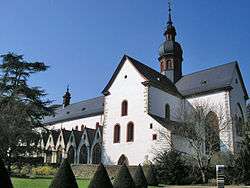
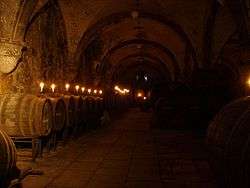
Since the Verona donation in 983, the Rheingau belonged to the archbishopric of Mainz. Legend has it that Charlemagne let the first vineyards be planted in the region, close to present-day Schloss Johannisberg.[2] However finds like a Roman origin grapevine cutting knife point to even earlier cultivation. Better documented is the early influence of the church on Rheingau winemaking, which was controlled from Eberbach Abbey. Augustinians and Benedictines are known to have inhabited the area of the later abbey from 1116, and in 1135 the Cistercians arrived, sent out from Clairvaux. Legend has it that the Cistercians, which are also credited with having founded the wine industry in Burgundy, brought Pinot noir with them to Rheingau, although the earliest record of the grape variety in Rheingau is from 1470.[3] The slopes down from the Taunus mountains belonging to Kloster Eberbach were planted as vineyards in the 12th Century, and early in the 13th Century the vineyards had reached their present area. In medieval times, more red than white wine was produced, usually as Gemischter Satz, i.e. the vineyards were planted with mixed varieties which were vinified together.

In 2011 it was unveiled, that the Official Wine Classification in the Rheingau has a 150 years history. The classification was the basis for taxation of wineries after the annexation of the Duchy of Nassau by the Kingdom of Prussia in 1866. In the book Der nassauische Weinbau published in 1867 by Friedrich Wilhelm Dünkelberg a historical map Weinbau-Karte des nassauischen Rheingaus (Viticultural map of the Rheingau in the Duchy of Nassau), all known vineyards at that time had been mrked [marked] up by colour, evaluated and classified in first class vineyards (I. Klasse), second class vineyards (II. Klasse) and the remaining vineyards .[4][5]
As first class vineyards (I. Klasse) only 13 Lagen in 9 boundaries had been classified:
| Boundary | Name of the Lage |
|---|---|
| Rauenthal | Gehren, Wieshell, Rothenberg |
| Kiedrich | Grävenberg |
| Erbach | Marcobrunn |
| Hattenheim | Steinberg |
| Johannisberg | Schloss Johannisberg |
| Geisenheim | Rotheberg |
| Rüdesheim | Hinterhaus, Rottland, Berg |
| Assmannshausen | Hinterkirch (Rother Wein) |
| Hochheim | Dom-Dechanei |
Villages and producers
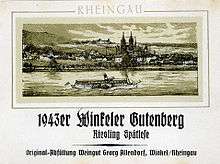
Some villages of Rheingau, listed in the downstream direction of Rhine, with some notable vineyards and producers.
- Hochheim am Main
- vineyards Domdechaney, Kirchenstück and Hölle
- Weingut Künstler
- Weingut W.J. Schäfer
- Walluf
- Eltville
- Hessische Staatsweingüter Kloster Eberbach ("Hessian State Wineries"), will move to a newly constructed cellar next to the vineyard Steinberg
- Rauenthal
- vineyards Baiken and Nonnenberg
- Kiedrich
- vineyard Gräfenberg
- Weingut Robert Weil
- Hattenheim
- vineyards Mannberg and Wisselbrunnen
- vineyard Steinberg, next to Kloster Eberbach, does not use a village name in its vineyard designation
- Hessian State Wineries (Hessische Staatsweingüter Kloster Eberbach) has its main cellars in a newly constructed facility next to the Steinberg vineyard, after having previously been located in Eltville
- vineyard Marcobrunn, is shared with the neighbouring village of Erbach
- Oestrich
- vineyards Doosberg and Lenchen
- Weingut Josef Spreitzer
- Weingut Peter Jakob Kühn
- Winkel
- vineyards Hasensprung and Jesuitengarten
- Schloss Vollrads, both a producer and a vineyard name, does not use a village name in its vineyard designation
- Johannisberg
- Schloss Johannisberg, both a producer and a vineyard name, does not use a village name in its vineyard designation
- Rüdesheim
- vineyards in Rüdesheimer Berg, primarily Berg Roseneck, Berg Rottland and Berg Schlossberg
- Weingut Georg Breuer
- Weingut Josef Leitz [6]
- Weingut Dr. Heinrich Nägler
- Assmannshausen
- vineyard Höllenberg, famous for its red wines
- Weingut August Kesseler
Grape varieties
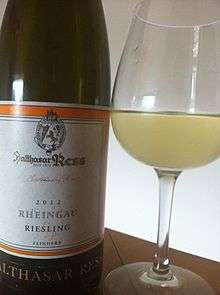
The most cultivated grape varieties, by area in 2008, were:[7]
|
|
References
- ↑ German Wine Institute: German wine statistics 2009/2010
- ↑ Wein-Plus Glossar: Rheingau, read on January 22, 2013
- ↑ Wein-Plus Glossar: Kloster Eberbach
- ↑ Daniel Deckers 2011: Die erste Lagenklassifikationskarte der Welt galt im Jahr 1867 dem Rheingau the first cadastral map for wine classification applied to the Rheingau
- ↑ dilibri Rheinland-Pfalz: Der nassauische Weinbau : eine Skizze der klimatischen, Boden- u. Cultur-Verhältnisse des Rheingau's. Hrsg. von Friedrich Wilhelm Dünkelberg
- ↑ Weingut Josef Leitz in Rüdesheim, Rheingau, holds the title for the “best white wine collection of the year” 2007
- ↑ Landwirtschaftliche Bodennutzung - Rebflächen - Fachserie 3 Reihe 3.1.5 - 2008 [Agricultural land use - Areas under vine]. Wiesbaden, Germany: Statistisches Bundesamt. 2008.